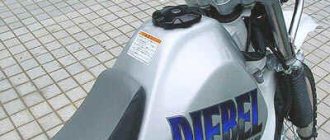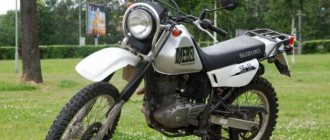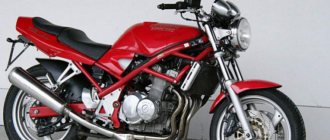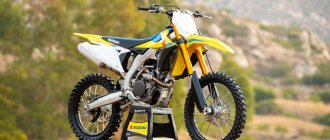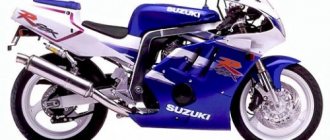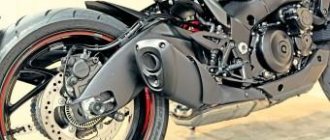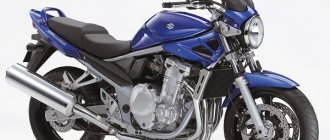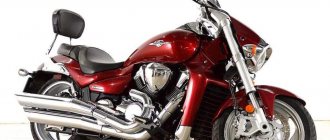Many bikers come to the conclusion that they want to be the happy owner of an enduro. But today there are many different and interesting options on the market, each with its own advantages and disadvantages, so sometimes it can be very difficult to choose an enduro motorcycle for yourself.
Today we will look at a universal option that has a lot of advantages - the enduro Suzuki Djebel 250. This motorcycle is considered quite popular in its class of off-road motorcycles with a 250 cc engine. Moreover, you can even ride this motorcycle on public roads without much discomfort. Suzuki Djebel 250 was produced until 2008. The first Djebel 250 appeared in 1992, it was created on the basis of the Suzuki DR250S (DR 250R). The engine in Jebel is the same as in its predecessors, but the fork is different and the headlight has become larger.
What's good about the Jebel is that it comes with a kick starter installed right at the factory. Since 2000, even before 2000, the kick starter was considered an additional option. Until 2000, this enduro was equipped with a TM28 carburetor, but it did not perform well because it was sluggish at low speeds. Therefore, after 2000, they began installing a BSR32 carburetor on Jebel; at low speeds the motorcycle behaved well, but at high speeds it became dull.
After environmental regulations were tightened in 2008, this motorcycle was removed from the production line.
Differences between Suzuki Djebel 250 and Suzuki DR250R
The DR250R and Djebel 250 motorcycles were produced simultaneously for a long time and they have a lot in common: engine, suspension. The differences between these motorcycles are that the DR has a smaller fuel tank than the Djebel 250, and their headlights are different, the Djebel has a large round headlight, and the DR has a small and square one.
Price Suzuki Djebel 250
The price of this motorcycle is a little scary, and all enduro motorcycles cost a lot. But when you ride behind the wheel of such a motorcycle, you realize that the money was well spent. Enduro gives a lot of pleasant and unforgettable emotions. Since today a new “Jebel” cannot be found, because it has not been produced for a long time, so you need to look for it among used motorcycles.
Old Suzuki Djebel 250 cost about 90 thousand rubles, but their condition leaves much to be desired. If we take models before 2000, then their prices are in the range of 130,000 rubles, but models that were released after 2000 are sold at prices from 130,000 to 180,000 rubles.
Jebel's competitors
There are many different 250cc enduro bikes on the motorcycle market. The main alternative to the Jebel is the Honda XR 250. But the XR is more off-road and is not very comfortable to drive on public roads. There is also a lightweight enduro Yamaha TTR 250, although over time it develops some technical problems. Then there is the Kawasaki KLX 250, but due to the fact that it is water-cooled, it is not very popular among endurists.
So, the most popular enduros with a 250 cc engine are considered to be Honda and Suzuki, while Yamaha and Kawasaki in Russia are quite rare in this class.
Three "firsts"
These motorcycles are not intimidating with the enormous power of their engines, but they also do not require frequent maintenance. They don't boast high-strength, high-tech suspension components and don't handle as sharply as more modern models, but they cost much less. For serious competition, they do not have very high ground clearance, but at the same time, the seat height is much lower than that of sports models. By today's standards they can be considered slightly outdated. But they are quite suitable for a first acquaintance with the world of enduro. Meet the Yamaha TT-R 250, Suzuki DR-Z 250 and Kawasaki KLX 250.
The acquaintance with this trio began with an activity called Hill climbing - climbing a hill. The short slope with ruts, holes and in places dug up loose soil was conquered without much difficulty even by me, riding a KLX with its semi-road or, rather, semi-off-road tires. Where the slope was mostly flat, it was possible to safely drive smoothly in second or third gear. It was necessary to resort to turning on the short first one very rarely - it is useful only when starting from a standstill on a very steep climb. And the fact that the KLX engine is the weakest in terms of maximum power is compensated by smooth traction from the very bottom without the pick-up at the top that is characteristic of the same TT-R 250. This makes him the friendliest of the three.
Suzuki DR-Z 250 249 cm3 n.a. 1 cylinder 115 kg $5500
While the Yamaha TT-R 250 and Suzuki DR-Z 250 are 80% off-road and 20% on-road, Kawasaki is 50/50. This is evidenced not only by the all-mountain tires, but also by a fully functional dashboard, a small metal trunk, and the absence of the kick starter hole found on the other two bikes. In addition, the KLX 250 is the only bike of this trio equipped with a liquid cooling system. Everything tells us that the motorcycle was in the wrong place at the wrong time (read: test). That is why it would not be entirely correct to compare it as an equal with the other two motorcycles. It is a different, not bad at all, universal motorcycle. The ease with which he conquered steep climbs and paths is a credit to him. Just don’t overestimate its capabilities and rush into the windfall - it’s not designed for that.
In our test, the Kawasaki KLX 250 lagged behind also because of the all-purpose tires installed on it. If it had been replaced with an off-road one, he could have shown better results. Even though it lags behind in terms of engine power, it is at a high level in terms of controllability due to the “front end” design being different from others. After all, it is the only one equipped with an inverted fork, while the competitors in the test have conventional forks that are not distinguished by high bending and torsional rigidity. That is why the KLX is more informative when steering, and allows you to accurately follow the trajectory even when the front wheel drifts.
Therefore, it is more friendly for beginners who have not ridden enduro at all. For them, KLX will be the best option of this trinity. Those who have at least a little experience, or for whom “250s” are the next stage of development after “125s” (or less cubic capacity equipment), should not opt for it.
Suzuki DR-Z 250 is noticeably more powerful and more suitable for complete off-road use. But to realize all the possibilities inherent in it, certain skills are required. Its reactions to movements with the throttle handle are sharper. Although this is not only due to the more powerful engine. Unlike the Kawasaki, the off-road rear tire grips the ground better, which minimizes drive wheel idling and allows the bike to climb onto the rear wheel more easily.
The chassis seems more compact and cohesive - this is probably due to the rigid frame that was once inherited from the RM-Z motocross bike. This is also where the geometry of the steering column comes from. All this gives the DR-Z 250 excellent handling and feedback from the road. The pilot feels everything that is happening under the wheels of the bike and can react in time to drift or wheel slip.
Kawasaki KLX 250 249 cm3 24 hp 1 cylinder 119 kg $5500
In terms of handling, this motorcycle is the most stable of the three thanks to a moderately stiff suspension, which efficiently handles both small and large irregularities. Because of this, the wheels are almost constantly in engagement with the ground or other surfaces, obstacles that may be encountered along the way. It has the same suspension travel as the Yamaha TT-R 250, but only on the DR-Z can it be used to the maximum during everyday, not very aggressive driving.
Suzuki's gearbox also deserves praise. Of the three, she is the clearest. On the same Kawasaki KLX 250, when driving up a steep slope, the second gear slipped out more than once when I accidentally lightly pressed the gearshift lever. The Yamaha TT-R 250, on the contrary, has a gearbox that is too rigid, and therefore there were problems.
The TT-R 250 made you feel from the very first meters that it was not like the others. Its engine is tuned for maximum performance at the top, and therefore low speeds were sacrificed - it practically does not pull at them. To achieve sharp acceleration, this engine must be constantly cranked, and riding under tension, as can be done on the other two bikes, is no longer fun. But that's the whole thrill of driving the TT-R. It allows you to feel like a pilot of not just an enduro, but a sports enduro. But at the same time, it makes the inexperienced pilot feel that he has not yet “grown up.” The behavior of the TT-R can frighten a beginner, and sometimes even play a cruel joke on him.
The motorcycle reacts to steering movements much more sharply than others. The chassis is just as well-built as the DR-Z, but the suspension settings are firmer from stock. On the TT-R 250, I often found myself flying through a series of bumps or going over them in a corner with constant sideways drift on both wheels. These same sections were driven on the DR-Z much more stable and without the extreme sensations that the TT-R 250 gives with enviable consistency.
Yamaha TT-R 250 249 cm3 28 hp 1 cylinder 120 kg $4900
But the hard suspension settings of the TT-R 250 will appeal to those who like to jump over rocks, jump off trampolines, climb over logs and other obstacles. In such situations, they provide maximum ground clearance, which allows the motorcycle to sit on its “belly” less often. And in general, the Yamaha is the toughest motorcycle in every sense, and therefore will be a good choice for those who soon want to switch to a cross-country bike. This motorcycle is the least inclined to forgive the pilot’s mistakes, and therefore it is better not to ride it without prior preparation. In addition, the TT-R requires more time to get used to the driving style typical of cross-country racers.
Verdict: The Yamaha TT-R 250 and Suzuki DR-Z 250 are quite capable of going where modern sports 250s can go. Perhaps not so quickly and confidently. A Kawasaki KLX 250 is suitable for those who will spend more time on the pavement rather than off it.
Text: Vladislav Sofonov
The main advantages of the Suzuki Djebel 250
Reliability
Jebel, unlike many other enduros, requires an oil change every 5,000 km. If you operate this device correctly, it can easily travel 120,000 kilometers. And thanks to air-oil cooling, the Djebel 250 easily travels at a speed of 120 km/h without overheating the engine. The design of the Suzuki Jebel is also reliable, the rigid frame can easily withstand serious falls.
Riding long distances
Many enduro bikes are simply not suitable for long-distance riding on regular paved roads due to their uncomfortable seats and small fuel tank, but the Djebel 250 has a 17-liter gas tank, a comfortable saddle and even a luggage rack.
“Jebel” can easily be called the most balanced enduro, because it can ride easily in mud and feels great on asphalt. Of course, driving an enduro on a flat road is not particularly interesting, but there are examples that were able to travel 1600 km on Jebel. on a public road in just 24 hours.
Sturdy suspension
The ground clearance of the Djebel 250 is 30 centimeters, and the suspension travel is 28 cm, which makes various holes, curbs and speed bumps invisible.
Review of the Suzuki Djebel 250 motorcycle (XC, GPS)
This is a legendary motorcycle belonging to the off-road enduro class. I bought it in 2009. He was the third in my life. It is legendary because it is mega reliable and people use it to travel around the world, because you know for sure that it will not let you down and you can fill it with any fuel, up to 76.
Single-cylinder air-cooled engine, 31 hp. s., is quite enough to overcome any off-road conditions, and accelerates the motorcycle to 136 km/h. The carburetor is installed in such a way that it can be removed at any time with a screwdriver, even in the field if necessary. And in general, it is made so that minor repairs can be made at any time and anywhere, using an adjustable wrench and a screwdriver. The motorcycle weighs only 118 kg, so it can easily overcome the heaviest off-road conditions without any problems. It was never possible to get him stuck in the mud so that he could get out. But in extreme cases, you can simply pull it out by hand. One day I was driving with a friend along a clearing in the forest in the spring, the water was knee-deep, it felt like you weren’t driving, but swimming.
The suspension is soft, you can overcome the sunbeds without slowing down by about 100 km/h. And you can jump from a springboard, but not higher than a meter, otherwise it will pierce the suspension. Light is a separate issue, the headlight is as much as 200 watts, at night it shines as if you were driving during the day and you can see every bump and hole. On most enduros, the headlight is just an accessory, but here it's an individual sun on the handlebars. This same headlight cuts through the wind in front of you quite well; up to 110 you don’t even have to bend down to the tank.
The tank holds 17.5 liters, and you can travel 400 km on one fill, which is very conducive to long trips. The dynamics are rather weak, it’s hard on the highway, especially if you need to overtake someone. I drove it around all the protected areas within a radius of 200 km from my home. The seat is also quite soft (for the enduro class), my butt got numb after about half an hour, it was enough to stand on the move for five minutes and sit again for half an hour. A friend had the same one, and he didn’t get numb at all. The plastic is specially flexible and is ready for impacts and bends, so falls are not scary, only the tank suffers since it is made of metal. The stock has a trunk on which you can install a case if desired, and a kick starter, so a discharged battery is not a problem, you can always start it with a kick.
The engine resource is approximately 100,000 km, while you can replace only the piston and drive for another 100 thousand. The motorcycle is extremely versatile, you can ride around the city in traffic jams, or go around it through a forest, a field, along an underground pedestrian crossing, or ride to a neighboring region, or even to the other side of the world, and this device will never let you down. If a biker on a chopper says that he is free, don’t believe him, enduro, this is real freedom. A very reliable and devoted friend for all occasions.
The motorcycle is suitable for absolutely everyone: girls, boys, beginners and pros. This device has almost no disadvantages, except for sluggish dynamics. I would recommend it to anyone who wants to join the wonderful world of enduro, as a first or maybe permanent motorcycle.
+ good handling on asphalt
+ stability at speeds over 100 km/h
+ rich equipment
+ decent acceleration dynamics
— weak traction at low speeds
- heavy weight
Disadvantages of the Suzuki Djebel 250
Rear shock absorber cannot be repaired
The rear shock absorber cannot be repaired in Jebel, so if it breaks, you will have to replace it completely.
The footrest sensor sometimes works when it shouldn't
The footrest sensor forcibly turns off the engine if the motorcyclist has engaged the gear but has not removed the footrest. This is a convenient function for beginners, but it often happens that when, due to serious off-road jumps, this sensor is triggered and turns off the engine, it becomes inconvenient. Therefore, many experienced jebelovods turn off this sensor.
Tuning Suzuki Djebel 250
Each motorcycle can be upgraded and added with new elements to provide protection or ease of movement, as well as make your motorcycle unique. The following improvements are very often made for Suzuki Jebel:
Install an even larger tank. The Jebel already features a large fuel tank, but some off-road travel enthusiasts want even more and install a 25-30 liter tank instead of the standard one. Such tanks cost around 10-20 thousand rubles.
Installation of protection for the engine. Despite the high ground clearance, there are obstacles that can damage the crankcase if you drive over them unsuccessfully, so to be completely sure, you can install crankcase protection. As a rule, such protection will cost no more than 7,000 rubles, but you won’t have to worry about damaging the motor.
Windshield installation. Usually, an enduro does not need a windshield, because it travels at speeds less than 120 km/h, but despite this, some motorcyclists install it; it costs around 1,500 rubles.
Installation of protection for levers. If you fall unsuccessfully, you can break the clutch or handbrake lever; to prevent this from happening, it is necessary to install protection in the form of metal arcs around the levers. There is also an accessory such as wind protection for the hands, which greatly helps the biker when riding long distances.
Replacing the standard saddle with a more comfortable one. The Jebel has the most comfortable saddle when compared to other enduros, but some Jebel riders change this saddle to a more comfortable one.
So, for tuning Jebel there are many different options, it all depends on your imagination.
SUZUKI INTRODUCES 2021 MODELS
Suzuki is celebrating its 100th anniversary and has announced a range of 2021 models, including motocross bikes, dual sport bikes and trail bikes. There are no major changes, but the company now offers the MX Tuner 2.0 tuning app for smartphones. Here is the official message from Suzuki:
Suzuki celebrates its 100th anniversary as a company in 2021. Originally founded as a weaving loom manufacturer in Hamamatsu, Japan, Suzuki has grown into a global leader in automobiles, boats, motorcycles and ATVs. Suzuki's performance-based DNA is alive and well in all of its first 2021 PowerSports models, including the race-ready Suzuki GSX-R sport bikes, RM-Z motocross machines, DR-Z Off-Road/DualSport motorcycles, and the KingQuad and QuadSport all-terrain vehicles.
MOTOCROSS
2021 SUZUKI RM-Z450
As one of the most successful brands in the history of the sport, Suzuki motocross machines remain the champion's choice as their sleek, cutting-edge looks, powerful yet reliable engine and natural ergonomics continue to reflect Suzuki's racing identity.
The RM-Z250 and RM-Z450 siblings embody Suzuki's "Winning Balance" philosophy with strong brakes for controlled braking, a broad engine torque band with high peak power, and a strong, light and agile chassis that remains standard in the class. cornering characteristics and unusually precise handling. Add to this the best ergonomics, beautiful styling and unrivaled reliability, and you have the perfect racing machine.
2021 SUZUKI RM-Z250
The RM-Z250 and RM-Z450 return with updated graphics for 2021, as well as the ability to now tune electronic fuel injection and ignition for maximum performance thanks to Suzuki's MX-Tuner 2.0 mobile unit and proven fuel. pairing system included with the 2021 RM-Z250 and RM-Z450. Now you can easily customize your motorcycle according to track conditions or your riding preferences on your personal device.
2021 SUZUKI RM '85
The RM85 returns with updated graphics for 2021 and continues the tradition of racing excellence. Like its larger RM-Z siblings, the RM85 delivers renowned Suzuki handling for experienced junior riders and newbies alike. With a reliable two-stroke engine, smooth power delivery and easy handling, the RM85 is the ideal motocross bike for anyone learning to race and looking to win.
2021 Suzuki RM-Z450
MSRP $8,999
Click here for more details (https://suzukicycles.com/Product%20Lines/Cycles/Products/RM-Z450/2021/RMZ450.aspx)
2021 Suzuki RM-Z250
MSRP $7,899
Click here for more details (https://suzukicycles.com/Product%20Lines/Cycles/Products/RM-Z250/2021/RMZ250.aspx)
2021 Suzuki RM85
MSRP $4,299
Click here for more details (https://suzukicycles.com/Product%20Lines/Cycles/Products/RM85/2021/RM85.aspx)
DualSport / SuperMoto models -
2021 SUZUKI DR-Z400S
Suzuki's DualSport and SuperMoto machines are some of the most versatile, reliable and fun motorcycles available on the market.
The 2021 Suzuki DR-Z lineup includes the rugged, reliable go-anywhere DR-Z400S and the best of both worlds, the SuperMoto DR-Z400SM. The DR-Z400S and DR-Z400SM return with new colors and stylish graphics for 2021.
2021 Suzuki DR-Z400S
MSRP $6,899
Click here for more details (https://suzukicycles.com/Product%20Lines/Cycles/Products/DR-Z400/2021/DRZ400S.aspx)
2021 Suzuki DR-Z400SM
MSRP $7,499
Click here for more details (https://suzukicycles.com/Product%20Lines/Cycles/Products/DR-Z400/2021/DRZ400SM.aspx)
Off-road models -
2021 SUZUKI DR-Z125
If you're looking for a family-friendly ride, Suzuki's off-road motorcycles are the way to go. Suzuki's off-road machines offer young and short riders a great combination of reliable off-road performance, premium features and champion-approved RM-Z style.
The DR-Z50 is the perfect way to introduce young, aspiring riders to the sport of motorcycling. This compact mini bike from Suzuki offers ease and convenience for riders who are just getting started on two wheels. The DR-Z125L is the perfect next step in Suzuki Off-Road motorcycle development and is designed to deliver high performance performance from a size-appropriate motorcycle. Both the DR-Z50 and DR-Z125L will return with new graphics for 2021.
2021 SUZUKI DR-Z 50
2021 Suzuki DR-Z50
MSRP $1,799
Click here for more details (https://suzukicycles.com/Product%20Lines/Cycles/Products/DR-Z50/2021/DRZ50.aspx)
2021 Suzuki DR-Z125L
MSRP $3,349
Click here for more details (https://suzukicycles.com/Product%20Lines/Cycles/Products/DR-Z125L/2021/DRZ125L.aspx)
